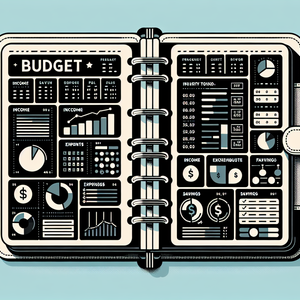The Ultimate Portfolio Blueprint for Aspiring UI/UX Designers

The first step in creating a compelling portfolio is to choose the right projects to showcase. Quality over quantity is key; it's better to present a few well-executed projects than a multitude of mediocre ones. Here are some considerations for selecting projects: - Highlight Your Range: Include a variety of work that demonstrates your versatility, such as web design, mobile app design, and user research. This shows potential employers that you can adapt to different mediums and challenges. - Showcase Your Process: Select projects where you can clearly illustrate your design process, from research and ideation to prototyping and testing. - Reflect Your Interests: Choose projects that align with your passions or areas of interest within UI/UX design.
2. Presenting Case Studies
Case studies are a powerful way to communicate your design thinking and rationale. When preparing your portfolio, consider the following elements for each case study: - Problem Statement: Start by clearly defining the problem you aimed to solve. - Research Findings: Share insights from user research, market analysis, or competitor studies. - Design Process: Walk the reader through your design process, including sketches, wireframes, and prototypes. - Final Outcome: Conclude with the finished product, showcasing high-quality images or interactive prototypes.
3. Showcasing Design Skills Beyond Software Proficiency
While technical skills are essential in UI/UX design, soft skills play a crucial role in your effectiveness as a designer. Ensure your portfolio reflects these attributes by: - Emphasizing Collaboration: Highlight projects where you worked as part of a team. - Demonstrating Empathy: Explain how you approached user-centered design by considering the needs and feelings of your users. - Problem-Solving Examples: Include narratives that showcase your ability to tackle challenges creatively.
4. Creating a Visually Engaging Presentation
The aesthetics of your portfolio are just as important as the content. A visually appealing layout can enhance the viewer's experience and keep them engaged. Consider these tips: - Consistent Branding: Use a consistent color palette, typography, and layout throughout your portfolio. - Interactive Elements: If possible, incorporate interactive elements that allow potential employers to engage with your work. - Responsive Design: Ensure your portfolio is accessible across devices.
5. Seeking Feedback and Iterating
Finally, don't hesitate to seek feedback on your portfolio from peers, mentors, or industry professionals. Constructive criticism can provide valuable insights and help you refine your work.
Building a standout portfolio is a vital step for aspiring UI/UX designers aiming to break into the industry. By carefully selecting projects, presenting detailed case studies, showcasing essential soft skills, creating a visually engaging layout, and seeking feedback, you can craft a portfolio that not only impresses potential employers but also reflects your unique design philosophy.
UI/UX Designer
Tech startups, e-commerce platforms, and digital agencies
Core Responsibilities
Design user-centered interfaces for web and mobile applications based on user research and testing.
Collaborate with product managers and developers to iterate on designs based on feedback and usability testing.
Create wireframes, prototypes, and high-fidelity designs that effectively communicate design concepts.
Required Skills
Proficiency in design tools like Sketch, Adobe XD, or Figma.
Strong understanding of user-centered design principles and usability testing methods.
Excellent communication skills for presenting design ideas and collaborating with teams.
Interaction Designer
Software companies, UX consulting firms, and mobile app developers
Core Responsibilities
Develop interactive prototypes that demonstrate the functionality and user experience of digital products.
Conduct user research to understand user needs and behaviors, using insights to inform design decisions.
Collaborate with visual designers and developers to ensure cohesive and functional interaction designs.
Required Skills
Experience with prototyping tools such as InVision, Adobe XD, or Axure.
Knowledge of interaction design principles and frameworks (e.g., micro-interactions).
Strong analytical skills to interpret user data and feedback.
User Researcher
Market research firms, UX consultancies, and tech companies with a focus on user-centric products
Core Responsibilities
Conduct qualitative and quantitative user research to inform design decisions and improve user experiences.
Create user personas and journey maps based on research findings to guide product development.
Present findings and recommendations to cross-functional teams to influence design and product strategy.
Required Skills
Proficiency in research methodologies such as interviews, surveys, usability testing, and A/B testing.
Strong analytical skills and experience with data analysis tools (e.g., SPSS, Excel).
Excellent storytelling abilities to convey research insights effectively.
Visual Designer
Marketing agencies, e-commerce brands, and tech companies focused on product design
Core Responsibilities
Create visually appealing designs for digital products, ensuring alignment with brand guidelines and user experience principles.
Work closely with UI/UX designers to enhance the overall aesthetic of the user interface while maintaining usability.
Develop design assets including icons, graphics, and typography for various digital platforms.
Required Skills
Proficiency in graphic design software such as Adobe Photoshop, Illustrator, and InDesign.
Strong portfolio showcasing a range of visual design projects and styles.
Understanding of responsive design and accessibility standards.
Product Designer
Tech giants, product-focused startups, and design-driven organizations
Core Responsibilities
Lead the end-to-end design process for digital products, from research and ideation to prototyping and final implementation.
Collaborate with cross-functional teams to define product requirements and specifications based on user needs.
Conduct usability testing and iterate on designs based on user feedback and analytics data.
Required Skills
Experience in both UI/UX design and product management principles.
Strong proficiency in design software and prototyping tools.
Ability to balance user needs with business objectives and technical constraints.


